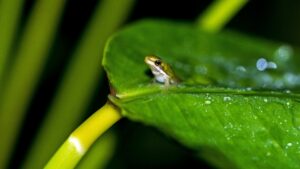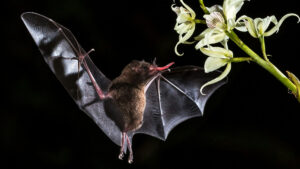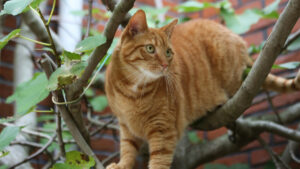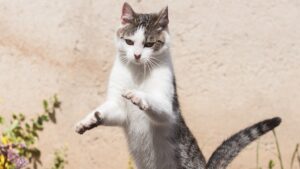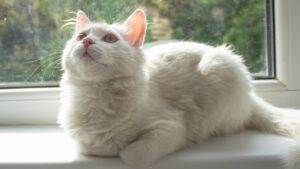As a cat parent, you’ve probably witnessed your furry companion’s undeniable fascination with catnip. The sight of them rolling around, purring with delight, and generally acting like they just stumbled upon the feline equivalent of a Las Vegas buffet is a common one. But what exactly is catnip, and why do cats love it? Let’s take a look at this herbaceous enigma and uncover the secrets behind cats’ love affair with it.
What is catnip?
Catnip, scientifically known as Nepeta cataria, is a member of the mint family, and it’s a herbaceous perennial that grows like a weed in many parts of North America. But while it may be considered a pesky plant by some gardeners, to our feline friends, it’s pure gold. Catnip contains a compound called nepetalactone, per the Humane Society. Nepetalactone is primarily found in the leaves, stems, and seeds of the plant. This compound is the secret sauce that sends cats into a state of euphoria.
The catnip experience: What does it do to cats?

So, what happens when a cat encounters catnip? Well, it’s like the ultimate kitty spa day, with some psychedelic overtones. When cats sniff, lick, or chew catnip, they experience a series of behavioral changes that can include:
- Rolling and rubbing: Cats often start by rolling and rubbing their bodies against the catnip source. It’s like they’re trying to soak up every last bit of that intoxicating scent.
- Purring and meowing: You might notice your cat purring louder than a Harley Davidson engine or meowing in excitement. These vocalizations are their way of expressing their delight.
- Playtime madness: Some cats get downright playful when they’re under the influence of catnip. They might chase invisible mice, pounce on imaginary prey, or simply engage in a wild game of “catch the tail.”
- Hyperactivity: Catnip can lead to bursts of energy, with cats zooming around the room like tiny, furry race cars. It’s like watching a feline version of the Olympics.
- Relaxation: Surprisingly, some cats also respond to catnip with a sense of relaxation. While others get hyped up, a few may just chill out and lounge around.
What causes the feline high?
Now, you might be wondering, why does catnip have such a powerful effect on cats? Well, it turns out that nepetalactone, the active compound in catnip, interacts with receptors in a cat’s nasal tissue and stimulates sensory neurons. This stimulation triggers a cascade of neurological responses that ultimately result in the wacky behaviors we associate with catnip. But it’s not all fun and games — catnip can also have a calming effect, depending on the individual cat and their sensitivity to it.
One way to think of catnip’s effects on cats is like a kitty high. It’s their version of a mind-altering substance, but without any long-term negative consequences. The high is short-lived, lasting only about 10-15 minutes, after which cats usually lose interest in the catnip and go about their business as if nothing ever happened. It’s their very own 15-minute party.
Is catnip safe?
The good news for cat owners is that catnip is generally safe for cats. It’s non-addictive, and even if your cat decides to party with it frequently, there are no known long-term health risks associated with catnip use. However, some cats may be more sensitive to catnip than others, and a small percentage (about 30% to 50%) of cats don’t react to it at all — the equivalent of being the designated driver at a wild party.
Catnip and kittens
You might be wondering if kittens can enjoy the catnip party as well. The answer is yes, but with a caveat. Most kittens don’t start to respond to catnip until they’re around 3 to 6 months old. Before that, catnip often has little to no effect on them. It would be as if you handed a toddler a cup of espresso — they’re just not ready for it yet.
The evolutionary connection
Now, let’s get a bit scientific. Why do cats have this peculiar relationship with catnip in the first place? It turns out that the reaction to catnip is rooted in feline genetics and evolution. The response to catnip is inherited, and it’s thought to have evolved as a way to encourage cats to interact with the plant.
In the wild, catnip can serve as a natural insect repellent. When cats roll in it or chew on it, they release nepetalactone into the air, creating a barrier that helps keep pesky bugs at bay. So, a cat’s reaction to catnip may have evolved as a way to protect it from insects and parasites, making it not only a source of pleasure but also a survival advantage.
In the modern world of domesticated cats, the effects of catnip are more about amusement and entertainment than insect defense. But the evolutionary connection remains, and it’s fascinating to think that our house cats are still responding to a trait that helped their wild ancestors thrive.
Catnip products galore
Now that we understand the science and history behind catnip, it’s time to explore the wide world of catnip products. From traditional dried catnip to catnip-infused toys and treats, the pet industry has capitalized on our feline friends’ love for this herbal high.
- Dried catnip: The most common form of catnip is dried, crumbled leaves and flowers. You can find it in pet stores, online, or even grow your own catnip plant at home. Just sprinkle a pinch on the floor, and let the feline festivities begin!
- Catnip toys: Catnip-infused toys are a hit with many cats. These toys are designed to release the scent of catnip as cats play with them, creating an interactive experience that keeps them engaged and entertained.
- Catnip treats: For the foodie felines out there, catnip treats are a delicious way to enjoy the herb. These treats are often made with a sprinkle of catnip and can be an excellent reward for good behavior.
- Catnip sprays: If you want to introduce catnip to your cat in a controlled way, catnip sprays can be a great option. You can apply the spray to your cat’s favorite toys or scratching posts for a tailored catnip experience.
The catnip caveat: Use in moderation
RELATED: Surfing Cat Loves Riding the Waves in Hawaii — Hang 18!
While catnip is generally safe and fun for most cats, it’s essential to use it in moderation, per PetCareRx. Overexposure to catnip can lead to a decreased sensitivity to its effects. Think of it as having too much of a good thing until it loses its magic. To keep the novelty alive, limit your cat’s exposure to catnip to once every couple of weeks or as an occasional treat.
So, there you have it — the mystery behind why cats love catnip unveiled! It’s a blend of genetics, evolution, and a little bit of herbal magic. Whether your cat responds with wild enthusiasm or a Zen-like state of relaxation, one thing is for sure: catnip adds a touch of whimsy to the lives of our feline companions.
When you catch your cat indulging in some catnip-induced acrobatics, you can smile and appreciate the fact that, for a brief moment, your cat is experiencing their very own herbal high. Just remember to enjoy the show responsibly, and don’t be surprised if your cat gives you that look that says, “What happens in the catnip circle, stays in the catnip circle.”
RELATED: New Cat Pain Detector App Tells Humans When Their Cat Is Suffering
Header image: Cat jumping / Kanashi via Unsplash
I’m Mark Putzer, and my passion for animals and all things nature is a life-long love affair. Growing up in Wisconsin, I had many cherished memories of hiking, skiing, and enjoying the abundant wildlife in the Badger State.
My passion for animals led me to marine biology research for my studies at the University of Wisconsin. I researched the behavior and communication of humpback whales around Hawaii and Orca Whales around the San Juan Islands of Washington State. The experience of being close to these massive and magnificent creatures is amazing. Later, I taught outdoor education to children in California — passing along my knowledge of animals and nature to the curious minds of the next generation. I also love pets. This includes a Labrador Retriever dog named “Molly” when I was a kid — and now, an adventurous tabby cat named “Rosy.”
I’m here to share the wonders of the animal kingdom with you. Whether it’s a cherished pet at home or an animal out in the wild, there are many unique stories and interesting information to share on Weird Animal News! Enjoy!

